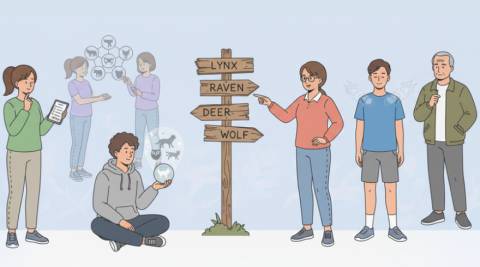The Ultimate Guide to Theriotype Quizzes: Meaning, Methods, and Benefits

What a Theriotype Exploration Really Involves
People who identify with animal archetypes often seek tools that help them contextualize instinctive pulls, sensory preferences, and dream imagery in a grounded way. A thoughtfully designed assessment can act as a mirror for lived experience, not as a rigid labeler. In this space, language matters, nuance matters, and personal pacing matters, because identity journeys are dynamic and unfolding rather than instant conclusions.
Many enthusiasts start their journey by trying a theriotype quiz as a baseline, and then they add journaling and community reflection. The best outcomes arrive when you approach results as working hypotheses, keep notes on seasonal shifts, and revisit your impressions after new life experiences. You can also pair reflective prompts with somatic awareness to notice how certain animal motifs resonate differently during stress, calm, solitude, or social settings.
- Use results to inspire questions rather than finalize answers.
- Track patterns across dreams, media preferences, and movement styles.
- Compare moods and environments that amplify or mute animal affinities.
Because identity is multifaceted, an assessment benefits from context like spirituality, culture, neurodiversity, and lifestyle. A supportive community can help surface blind spots and add language that feels precise without being confining. Over time, you’ll refine your understanding, shed outdated assumptions, and keep what consistently echoes through your daily life.
How Assessments Work: Signals, Scales, and Reliability
Responsible assessments typically combine qualitative prompts and quantitative scales to capture both narrative nuance and pattern strength. On the qualitative side, open-ended questions invite personal symbolism, sensory memories, and metaphors. On the quantitative side, Likert-style items probe frequency, intensity, and context for behaviors or preferences that map to archetypal clusters. When both parts are integrated, the resulting profile is richer and less prone to single-item bias.
Many participants evaluate reliability by retesting after several weeks, aiming to see whether core patterns remain stable while peripheral details evolve. That habit encourages clarity about situational noise versus enduring traits. For structured self-checks, some people try a theriotype test alongside a reflective journal to confirm whether daily experiences validate the indicated themes, especially across changing routines.
| Dimension | What It Captures | How It Informs Results |
|---|---|---|
| Instinctive Pulls | Immediate, gut-level resonances and aversions | Flags archetypes that consistently feel “home-like” |
| Sensory & Movement | Posture, pace, spatial preferences, tactile cues | Links bodily patterns to animal analogs and contexts |
| Inner Imagery | Dream motifs, meditative visuals, spontaneous symbols | Cross-checks narratives against behavioral indicators |
Because no questionnaire can fully contain a human life, it’s wise to treat outputs as provisional. You can annotate answers, note exceptions, and collect counterexamples that sharpen your picture. Over months, that living archive becomes both a personal compass and a reality check against impulsive conclusions.
Comparing Quiz Styles and Choosing the Right Fit
Different formats emphasize different strengths, so knowing your goals helps you select an approach. If you prefer story-rich exploration, long-form prompts with optional journaling space may suit you best. If you like pattern clarity, structured scales with clear anchors and well-defined subdomains can deliver quicker insight. Some hybrids start with a short screen and then branch into deeper modules based on your initial signals.
People who want breadth often sample a therian type quiz that surveys diverse behavioral and sensory domains, and then they compare those findings with lived observations. Others who value measurement repeat a therian type test seasonally to check whether core tendencies persist as circumstances change. Either way, you’ll gain more from results if you document context, sleep, stress, social load, and environment, because those factors can tilt responses in subtle ways.
- Screeners are fast but shallow; comprehensive tools take longer and offer nuance.
- Branching formats adapt to you, which can reduce irrelevant items and fatigue.
- Transparent scoring and clear definitions improve trust and interpretability.
Before committing, glance at sample items, read the definitions, and check whether the creators explain their method. When language resonates and the structure is transparent, you’re more likely to feel satisfied with the insights you receive.
Core Benefits: Clarity, Confidence, and Community Alignment
A well-made assessment functions like a compass, pointing toward patterns you might have intuited but struggled to articulate. That clarity often reduces second-guessing and helps you communicate your experience to supportive peers. When terminology clicks, you gain shared vocabulary for conversations about embodiment, sensory comfort, and ritual practices that nurture your well-being.
Curated frameworks also highlight the types of therians discussed in community discourse, which can help you discover reading lists and local groups that match your profile. Some participants prefer reflective formats such as a my therian type quiz that includes guided prompts to unpack memories and moments that feel especially resonant in daily life. Over time, those recorded snapshots reveal trajectories and inflection points that deepen self-trust.
- Better language for describing your lived experience to others.
- Personalized ideas for grounding, movement, and creative expression.
- Gentle structure for journaling and long-term self-study.
Another advantage is boundary-setting: when you understand your rhythms, it’s easier to decline mismatched activities and choose environments that feel congruent. That alignment tends to increase energy, creativity, and a stable sense of self across contexts.
Interpreting Results and Planning Next Steps
After receiving a profile, resist the urge to finalize an identity immediately; instead, treat the output as a working hypothesis. Start noting how different settings, indoors versus outdoors, busy versus quiet, shift your sense of resonance, and look for repeating signals. If certain motifs consistently reappear, you can gradually elevate them from possibility to likelihood.
Some people retake a what is my theriotype quiz after life changes like moving, job shifts, or new relationships, because context can amplify or soften certain traits. Others compare reflection-based tools with a more direct what is your theriotype quiz to see whether narrative and numeric paths converge on the same themes, which boosts confidence in the emerging picture. When discrepancies appear, they’re not failures; they’re invitations to dig deeper and refine your map.
- Document evidence for and against each indicated theme.
- Create small experiments, new routines, environments, or practices, and observe shifts.
- Seek feedback from trusted peers who understand nuance and consent.
By iterating slowly, you transform a single result into a durable understanding supported by lived data rather than fleeting impressions.
Accuracy, Limitations, and Responsible Use
Even strong instruments have blind spots, including cultural bias, translation issues, and situational distortion. That’s why responsible practitioners emphasize humility and continuous validation through real life. If you experience high stress, major transitions, or sleep disruption, consider postponing assessment or at least interpret scores with caution, because those forces can temporarily alter your responses.
People who are new sometimes gravitate toward a what type of therian am i quiz hoping for quick certainty, yet the most reliable clarity builds from repeated observations over time. Likewise, comparative tools like a therian animal type test can be helpful when used as one input among many rather than a solitary decider, especially if you track counterexamples that challenge your initial assumptions. Ethics also matter: avoid pressuring others to share results, and respect privacy and boundaries.
- Treat outputs as guides, not verdicts.
- Protect your data and share selectively with informed consent.
- Favor transparent instruments with clear definitions and version histories.
When you pair careful interpretation with compassion for yourself and others, assessments become tools for growth rather than boxes that constrain.
FAQ: Theriotype Quiz
How long should a comprehensive assessment take?
Most people feel satisfied with 15–30 minutes for a baseline, plus optional journaling afterward to expand on images, sensations, and memories that bubbled up during the process.
How often should I revisit my results?
Revisiting every few months works well for many, especially after major life changes, seasonal shifts, or new routines that might influence patterns and perceptions.
Can I combine multiple tools for better clarity?
You can triangulate by pairing a narrative-first approach with a structured option such as a what type of therian are you test to see whether themes align across formats and time.
What if two or more archetypes resonate equally?
Keep both in play while you collect more evidence, and consider experimenting with environment, movement, and creative practices to observe which context strengthens one theme over another, then compare with a what type of therian are you quiz during a calmer period.
How do I know if an instrument is trustworthy?
Look for transparent definitions, clear scoring, pilot data, and ethical guidance on privacy, plus community feedback that discusses strengths and limitations without hype.
Latest News



